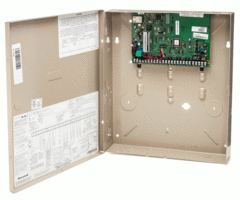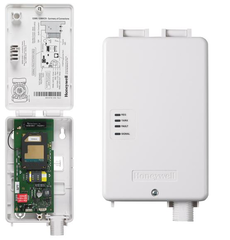Buyers Guide to Wireless Security Systems
Posted By Michael GorisHi DIYers! We recently made a post that compared wireless systems with hardwired ones. We ultimately concluded that most end users are better-suited with a wireless system. If you have decided that you need a wireless home security system, this buyer's guide can help you review the options.
Remember, no matter which system you buy, you will need an alarm monitoring plan to go along with with it. Please review our alarm monitoring page for more information. Below are some of the best wireless security systems on the market today and what makes them so great:

The Qolsys IQ Panel 2 Plus is arguably the most robust alarm system on the market today. Each version provides support for PowerG 915 MHz Sensors and a choice of one legacy sensor type (319.5 MHz, 345 MHz or 433 MHz). The PowerG Sensors are particularly renowned for their ability to be used from up to 2,000 feet away from the IQ2+ System in open air. This is also one of the few wireless all-in-one panels with the ability to display the live feed for Alarm.com Security Cameras right from its screen. The panel also includes a built-in LTE cellular communicator (AT&T or Verizon) and a fully functional Z-Wave Plus Controller. In fact, this is one of the very few systems where virtually no add-ons are needed. However, the IQ Panel 2 Plus is one of the more expensive wireless panels available on the market. But users will certainly appreciate its sleek, modern design and superb functionality. The system uses Alarm.com as its interactive service platform, and it can readily connect with the service. All versions of the IQ Panel 2 Plus can be seen here.
Choose the IQ Panel 2 Plus if:
- You want the remarkable signal range that comes with PowerG Sensors.
- You want the ability to easily bring over existing wireless sensors (319.5 MHz, 345 MHz or 433 MHz) with your new security system.
- You want the ability to view your security cameras right from your panel.
- You don't mind paying top-dollar for an alarm system.

The Honeywell Lyric Controller is still the flagship HomeKit security system from Honeywell, and the time-tested company has once-again produced an excellent panel. The Lyric is perhaps the best system on the market today for use with Apple HomeKit. It can pair natively with HomeKit in order to provide all of the functionality that a user would expect with the feature. The Lyric System also has its own lineup of encrypted sensors, called the Honeywell SiX Series. Additionally, it is backwards compatible with the Honeywell 5800 Series. Another factor that separates the Lyric from other systems is its ability to be used with Total Connect 2.0. This service is designed exclusively for Honeywell Alarm Systems, and it offers similar functionality to that of Alarm.com. The system's built-in WIFI card allows it to readily connect with the service. One downside to the Lyric is that it only includes a Z-Wave classic controller as opposed to a Z-Wave Plus controller. While it can support Z-Wave Plus devices, they will only have the capabilities of Z-Wave classic devices when used with this system. Please note, a separate Lyric Cellular Module is needed for cellular connectivity.
Choose the Lyric Controller if:
- You plan to use your alarm system with Apple HomeKit.
- You prefer using Total Connect 2.0 over Alarm.com.
- You want to use encrypted Honeywell SiX Series Sensors.
- You don't require a Z-Wave Plus controller.
 The 2GIG GC3 just gave itself a major upgrade in the form of partitioning support. This makes the GC3 the first ever AIO wireless system to support partitioning. 2GIG refers to this feature as "smart areas", and the system on the latest firmware, and up to four of these areas can be supported. Beyond that, the GC3 is also highly regarded for its strong build quality. That's not to say the other panels are lacking in that department, but the GC3 is perhaps the sturdiest system we have ever worked with. Its touchscreen controls are extremely responsive, and its full-color 7-inch display is a joy to look at. The system can use 2GIG 345 MHz Sensors and Honeywell 5800 Series Sensors. One weakness of the system is that it does not support any type of encrypted sensors at this time. But it does include a built-in Z-Wave Plus Controller for smart home devices. Like the IQ Panel 2 Plus, the system uses the Alarm.com service. But the user will need to buy a separate GC3 cellular communicator to use ADC.
The 2GIG GC3 just gave itself a major upgrade in the form of partitioning support. This makes the GC3 the first ever AIO wireless system to support partitioning. 2GIG refers to this feature as "smart areas", and the system on the latest firmware, and up to four of these areas can be supported. Beyond that, the GC3 is also highly regarded for its strong build quality. That's not to say the other panels are lacking in that department, but the GC3 is perhaps the sturdiest system we have ever worked with. Its touchscreen controls are extremely responsive, and its full-color 7-inch display is a joy to look at. The system can use 2GIG 345 MHz Sensors and Honeywell 5800 Series Sensors. One weakness of the system is that it does not support any type of encrypted sensors at this time. But it does include a built-in Z-Wave Plus Controller for smart home devices. Like the IQ Panel 2 Plus, the system uses the Alarm.com service. But the user will need to buy a separate GC3 cellular communicator to use ADC.
Choose the GC3 if:
- You need partitioning support.
- You want a system with superb build-quality.
- You want to use the Alarm.com platform.
- You don't need encrypted wireless sensors.

The 2GIG GC2 is our pick as a "budget" security system. We know that many people getting into home security will not need all of the advanced features that the state-of-the-art systems have to offer. That is where is the 2GIG GC2 comes into play. With the right support, it can still serve as an extremely viable option for many users. The panel features a 3.75" by 2.25" touchscreen with very responsive controls. This is considerably smaller than the 7-inch touchscreen displays of the other panels on this list, but it will work just fine for many users. The panel can support up to 60 wireless zones. Again, this is considerably less robust than the other systems, but it will be perfectly acceptable for most smaller and medium-sized homes. The system includes a Z-Wave classic controller for supporting smart home automation devices. In order to get the GC2 connected with Alarm.com, a separate GC2 cellular communicator is needed. Overall, if you're looking for a new security system at a reasonable price, you can't go wrong with the 2GIG GC2.
Choose the GC2 if:
- You're shopping for a system on a budget.
- You want a simple, yet capable alarm system.
- You don't need support for as many wireless zones.
- You don't need a larger touchscreen display.
If you still need help deciding on a wireless system, don't hesitate to reach out to us for support! You may email us any time at support@alarmgrid.com. Or you can call us at (888) 818-7728 from 9am to 8pm EST Monday thru Friday. We look forward to hearing from you!




 The next consideration that a user should make is the ease of use for the system. Most users find that wireless panels are much easier to use and program. These systems often feature built-in touchscreen controls and menus that are easy to navigate. With some minor instructions, an end user will be able to set up their wireless system in its entirety. Additionally, the touchscreen navigation will make it easier for the user to perform basic system functions like arming and disarming. This can be very important for users who aren't always the most tech-savvy.
The next consideration that a user should make is the ease of use for the system. Most users find that wireless panels are much easier to use and program. These systems often feature built-in touchscreen controls and menus that are easy to navigate. With some minor instructions, an end user will be able to set up their wireless system in its entirety. Additionally, the touchscreen navigation will make it easier for the user to perform basic system functions like arming and disarming. This can be very important for users who aren't always the most tech-savvy.






 In addition to being more convenient and easier to install, there is one other major advantage that wireless systems offer over wired systems. That is, wireless systems cannot be as easily tampered with. A hardwired sensor can have its line to the panel cut by a potential intruder so that it no longer functions properly. Of course, when this happens, the hardwired system will recognize this and trigger an immediate trouble situation. This makes this a relatively minor security concern. But it would still be very inconvenient to have to rewire the sensor and make sure that its working order has been restored.
In addition to being more convenient and easier to install, there is one other major advantage that wireless systems offer over wired systems. That is, wireless systems cannot be as easily tampered with. A hardwired sensor can have its line to the panel cut by a potential intruder so that it no longer functions properly. Of course, when this happens, the hardwired system will recognize this and trigger an immediate trouble situation. This makes this a relatively minor security concern. But it would still be very inconvenient to have to rewire the sensor and make sure that its working order has been restored.